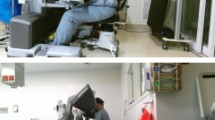Abstract
The use of the da Vinci robot in minimal invasive surgery comes with numerous advantages. Recent papers describe improvements in the ergonomic environment and benefits for the surgeon’s posture in the console. Ergonomics for first assistants or scrub nurses at the OR table during robot-assisted procedures, however, have gained minor attention. The aim of this study, therefore, is to analyse the ergonomic environment specifically for first assistants during robot-assisted surgery. Three techniques were used to evaluate body posture and ergonomics during three discriminated actions. First of all, a questionnaire was conducted. Second, sagittal and dorsal photographs of all first assistants were shot. From these photographs, joint angles of the trunk, neck, shoulder, elbow, pelvic girdle and spine were calculated and rapid upper limb assessment (RULA) scores were determined. In addition, intra-observer variability was assessed to determine the robustness of the results. Lastly, the number of obstructions during the surgery was registered by an observer present at the operation theatre. The questionnaires displayed that 73% of the first assistants were in uncomfortable working positions for longer periods of time. Twenty percent of the participants even report pain or visible bruising due to hinderance of the robot arm. Furthermore, an average of 2.8 obstructions per surgical procedure was registered, mainly affecting the lower arm (60%). The photographs demonstrated that all joint angles, except for the elbow joint, are potentially harmful when assisting during robot-assisted surgery. RULA scores revealed high-risk ergonomic risk scores for all measured actions. Tissue traction was recognized as the action with the highest physical workload. During robot-assisted surgery, first assistants experience non-ergonomic trunk, neck and shoulder angles. These recordings are supported by posture analysis. Tissue traction is reported as the most intensive action by the nurses. Tacking, however, can lead to the most unfavourable RULA score. The surgeon’s awareness of the position of the robot arms could reduce the number of obstructive moments for the first assistant. Lowering the number of instrument replacements is plausible to lead to better ergonomic postures for first assistant.


Similar content being viewed by others
References
Preliminary fourth quarter 2017 revenue Intuitive Surgical (2018) http://phx.corporate-ir.net/phoenix.zhtml?c=122359&p=irol-newsArticle&ID=2325993. Accessed 14 May 2018
Lanfranco AR, Castellanos AE, Desai JP, Meyers WC (2003) Robotic surgery: a current perspective. Ann Surg 239(1):14–21
Chopra S, Srivastava A, Tewari A (2012) Robotic radical prostatectomy: the new gold standard. Arab J Urol 10(1):23–31
Lawson EH, Curet MJ, Sanchez BR, Schuster R, Berguer R (2007) Postural ergonomics during robotic and laparoscopic gastric bypass surgery: a pilot project. J Robot Surg 1(1):61–67
Broeders IAMJ (2014) Robotics: the next step? Best Pract Res Clin Gastroenterol 28(1):225–232
Sari V, Nieboer TE, Vierhout ME, Stegeman DF, Kluivers KB (2010) The operation room as a hostile environment for surgeons: physical complaints during and after laparoscopy. Minim Invasive Ther 19(2):105–109
van Veelen MA, Nederlof EAL, Goossens RHM, Schot CJ, Jakimowicz JJ (2003) Ergonomic problems encountered by the medical team related to products used for minimally invasive surgery. Surg Endosc 17(7):1077–1081
Zihni AM, Ohu I, Cavallo JA, Cho S, Awad MM(2014) Ergonomic analysis of robot-assisted and traditional laparoscopic procedures. Surg Endosc https://doi.org/10.1007/s00464-014-3604-9
Alleblas CCJ, de Man AM, van den Haak L, Vierhout ME, Jansen FW, Nieboer TE (2017 Dec) Prevalence of musculoskeletal disorders among surgeons performing minimally invasive surgery: a systematic review. Ann Surg 266(6):905–920. https://doi.org/10.1097/SLA.0000000000002223 (Review)
Alleblas CC, Velthuis S, Nieboer TE, Sietses C, Stegeman DF (2015) The physical workload of surgeons: a comparison of SILS and conventional laparoscopy. Surg Innov 22(4):376–381. https://doi.org/10.1177/1553350615577480 (Epub 2015 Mar 22. PMID: 25801191)
van’t Hullenaar CDP, Hermans B, Broeders IAMJ (2017) Ergonomic assessment of the da Vinci console in robot-assisted surgery. Innov Surg Sci. https://doi.org/10.1515/iss-2017-0007
Hildebrandt VH, Bongers PM, van Dijk FJ, Kemper HC, Dul J (2001) Dutch Musculoskeletal Questionnaire: description and basic qualities. Ergonomics 44(12):1038–1055
Mcatamney L, Corlett EN (1993) RULA: a survey method for the investigation of work-related upper limb disorders. Appl Ergon 24(2):91–99
Szold A, Bergamaschi R, Broeders I, Dankelman J, Forgione A, Langø T, Melzer A, Mintz Y, Morales-Conde S, Rhodes M, Satava R, Tang CN, Vilallonga R (2015 Feb) European Association of Endoscopic Surgeons (EAES) consensus statement on the use of robotics in general surgery. Surg Endosc 29(2):253–288. https://doi.org/10.1007/s00464-014-3916-9
Tjiam OM, Goossens RJ, Schout BM, Koldewijn EL, Hendrikx AJ, Muijtjens AM, Scherpbier AJ, Witjes JA (2014) Ergonomics in endourology and laparoscopy: an overview of musculoskeletal problems in urology. J Endourol Endourol Soc 28(5):605–611
Shallaly GEL, Cuschieri A (2006) Optimum view distance for laparoscopic surgery. Surg Endosc 20:1879–1882
Author information
Authors and Affiliations
Corresponding author
Ethics declarations
Conflict of interest
Author CDP van’t Hullenaar, Author Paula Bos and Author Ivo Broeders declare that they have no conflict of interest.
Rights and permissions
About this article
Cite this article
van’t Hullenaar, C.D.P., Bos, P. & Broeders, I.A.M.J. Ergonomic assessment of the first assistant during robot-assisted surgery. J Robotic Surg 13, 283–288 (2019). https://doi.org/10.1007/s11701-018-0851-0
Received:
Accepted:
Published:
Issue Date:
DOI: https://doi.org/10.1007/s11701-018-0851-0




